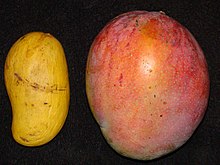Ataulfo (mango)

The Ataulfo, also called young, baby, yellow, honey, manila,[1][2] Adaulfo,[3] or Adolfo[4] is a mango cultivar from Mexico.[5] It is closely related to the Alphonso variety popular in India.
Ataulfo mangos are golden yellow and generally weigh between 6 and 10 ounces (170 and 280 g), with a somewhat sigmoid (oblong) shape[5] and a gold-blushed yellow skin.[1] Their buttery flesh is not fibrous, and they have a thin pit.[5][6] Their flesh is a deep yellow and high in sugar (15 grams per 100-gram serving), with a rich, spicy flavor.[5][6] They are rich in vitamin C and dietary fibre.[1]
Ataulfo mangos have only recently gained popularity in the United States, though they have been a major crop in Mexico for decades.[5] They come from the Mexican states of Michoacan, Sinaloa, Nayarit, Jalisco, Veracruz and Chiapas, and are sold between March and September.[1] As of 2009, they are the second-most popular variety of mango sold in the United States, behind the Tommy Atkins.[7]
In the Mexican state of Chiapas, mango production was, as of 2008, the sixth most important agricultural activity, based on cultivated surfaces, following corn, beans, coffee, sugar cane and cocoa. Ataulfo production in that state was concentrated in the Soconusco coastal region. Overall, producer organizations estimated that there were 18,000 hectares of Ataulfo mangoes in production in the state.[8]
References
- ^ a b c d Corey Mintz (May 24, 2008). "Sweet news: Ataulfos are in season; It's hard to believe these silky mangoes are related to the stringy variety we see in winter". Toronto Star.
- ^ "Ataulfo Mango". Produce Oasis. May 2011.
- ^ Tony Tantillo (September 16, 2008). "Yellow Mangoes". CBS3.com.
- ^ Sue Doeden (April 26, 2009). "I'm mad about mangoes". Bemidji Pioneer.
- ^ a b c d e Allen Susser. The Great Mango Book. Ten Speed Press (2001), p. 6 ISBN 1-58008-204-1.
- ^ a b Aliza Green. Starting with Ingredients. Running Press (2006), p. 572. ISBN 0-7624-2747-7.
- ^ Erica Marcus (June 10, 2009). "Mangoes win in popularity". St Louis Post-Dispatch.
- ^ Patrick Hanemann, Nathanael Bourns, Ivana Fertziger (July 2008). "Ataulfo Mango in Chiapas: A Value Chain Analysis" (PDF).
{{cite web}}: CS1 maint: multiple names: authors list (link) (USAID microREPORT #109

